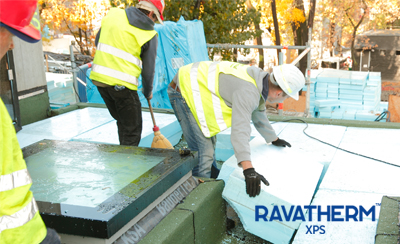The RAVATHERM XPS extruded polystyrene foam thermal insulation in high-thickness is suitable for installation in inverted flat roofs with various use. These products are welded from several layers, have excellent thermal insulation properties and they are also durable and easy to handle.
According to the constantly strictening energy standards, in the case of a new-built or renovated building, the thermal insulation of 24-28 cm thickness corresponds to achieve the thermal transmittance required for the flat roof. RAVATHERM Hungary kft. follows the increased demand with continuous product development, our product catalogue contains extruded polystyrene foam thermal insulation up to 28 cm thickness, which has also been used in this project.
High-thickness products are made by a special welding process, using two layers of polystyrene foam up to 22 cm and 3 layers up to 24-28 cm welded during thermoplastic process. Thanks to this process, the product retains its homogeneous material structure properties and thanks to multi-layer technology, the heat conductivity of the XPS remains excellent throughout the thickness range, which is outstanding; 0.035 W/mK, even for 28 cm thick material. In practice, therefore, the RAVATHERM XPS thermal insulation (laid in one layer) provides a thermal transmittance (U-value) less than 0,15 W/m2K on inverted roofs, which also meets the Passive House Standard. Welding technology allows us to expand our product range up to 40 cm in the future.
RAVATHERM XPS thermal insulation is an ideal choice for a combination of mixed, non-walkable inverted flat roofs and green roof surfaces. RAVATHERM XPS 300 SL extruded polystyrene foam thermal insulation up to 28 cm thickness is applied above the entire surface heat-melted, modified bituminous membrane waterproofing.
One of the many advantages of the reverse layer design is that it protects waterproofing from heat fluctuations, UV radiation and mechanical effects during construction, so the life span of built-in waterproofing can be several times higher than that of their counterparts exposed to weather.
As the layers to be installed after the waterproofing layer (extruded polystyrene foam thermal insulation, geotextile, ballast and covering layers) are not sensitive to water, roof insulation work can be scheduled much more freely, the construction schedule can be kept also in adverse weather conditions.
In addition of green roofs, it is important to note that the accompanying garden work (spade, hoe) can also easily damage waterproofing, so the reverse layer order is still the most plausible solution. The green roof is also a very eco-friendly solution. Vegetation helps to relieve the drainage of the sewer system, binds some of the dust, reduces summer warming and in case of sufficiently large area, also positively affects the microclimate of the city.




Leave a Reply